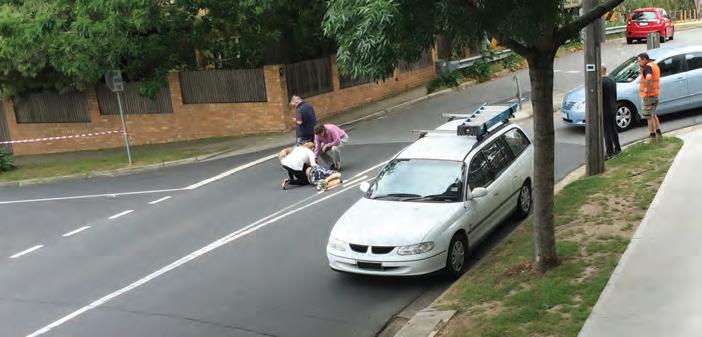
3 minute read
Blameless investigations
CRITICAL CRASHES AND BLAMELESS INVESTIGATIONS

People make mistakes – large and small – that lead to road crashes. But these mistakes don’t often warrant the price our community pays, which at this rate, will see 12,000 people killed and 360,000 admitted to hospital over the next decade: costing the nation over $300 billion.
Road trauma is a societal plague that has considerable impact on the prosperity, safety and health of the nation. However, achieving zero deaths on our roads is possible.
We have already begun to see examples of this on major routes including the Hume Freeway in Victoria, which recently had a zero-fatality year in 2019. This was primarily the result of the installation of safe system infrastructure in the form of 1500 kilometres of flexible barriers. Prior to the safety initiative, the Hume produced approximately 12 fatalities per month. Designing road infrastructure to prevent fatal and serious injury crashes is not insurmountable, and knowledge transfer and capability building efforts have ramped up over recent years. Separation, delineation, energy management, controls, lighting, speed management and user compliance are the common threads of the road safety dialogue. But, how do we know which road infrastructure treatments offer the best outcome for the money spent? How do we really know what role road infrastructure plays in preventing crashes?
Proactive and predictive road risk models are a leap of faith – we must be brave and justify spending on roads that appear reasonable to the traveling public. The more we investigate, the more knowledge we gain, and the more surety we have that we are spending on what we know is right, as opposed to what we intuitively think is right.
What are we doing to understand how the emergence of autonomous vehicles will affect road infrastructure? When a vehicle can prevent a crash on its own, how does the onus on infrastructure shift? Are Australia’s infrastructure managers preparing to address incidents involving an autonomous fleet of vehicles? It may surprise readers to learn that Australia is one of few first-world nations where there is no mandate to investigate road crashes as a matter of national public interest. In other nations, crashes are investigated using a “blameless” model, to frankly (and without bias) evaluate what role the road, the vehicle and the user played in the crash. As people who design, build and maintain road infrastructure, we are not currently getting the greatest and most complete learning from the crashes occurring on our roads, particularly those involving vulnerable road users, motorcycles, heavy vehicles and autonomous vehicles.
With the impending boom of connected and automated technologies on the horizon, and with the influx of population to our urban city centres, we will certainly see a rise in driverless, electric (possibly hydrogen), micro-mobility and heavy transport vehicles on our roads. Technological challenges such as vehicle-to-vehicle (V2V) and vehicle-toinfrastructure (V2I) technology advances and potential hacking ramifications must be understood, so that lessons can be immediately learned and applied.
Road managers cannot delay learning lessons from crashes and near-miss incidents on our roads.
For more information about ARRB’s transport safety initiatives, including blameless investigations, please contact Tia Gaffney (tia.gaffney@arrb.com.au), David McTiernan (david.mctiernan@arrb.com.au) or Paul Hillier (paul.hillier@arrb.com.au) .
You can also find out more at www.arrb.com.au/safety. HOW DO WE REALLY KNOW WHAT ROLE ROAD INFRASTRUCTURE PLAYS IN PREVENTING CRASHES? TIA GAFFNEY, DAVID MCTIERNAN AND PAUL HILLIER OF THE AUSTRALIAN ROAD RESEARCH BOARD INVESTIGATE. Figure 1: Scene of a pedestrian crash witnessed by one of the authors, Tia Gaffney, which was not investigated to determine the role the vehicle and road played in the crash. Mrs Gaffney reports that modern vehicle technology, such as automatic emergency braking or pedestrian impact protection could have prevented the impact. According to ARRB, this is a poorly designed intersection for pedestrians, despite a high proportion of pedestrian traffic at this location. Additional safe system infrastructure design would also have reduced the risk of such a crash here.

Low-cost level measurement. Radar sensor for water management.
Reliable level measurement in water treatment facilities, pump stations and rain overflow basins. Open channel flow measurement and water level monitoring.
VEGAPULS WL S 61 ▪ Measuring range up to 8 m ▪ Can be used outdoors without restriction ▪ Flood-proof IP 68 housing ▪ Operation via Bluetooth with Smartphone, tablet or PC
Further information: www.vega.com/wls61 Phone 1800 817 135
SHARE OUR VISION FOR BETTER PERFORMING ROADS IN











